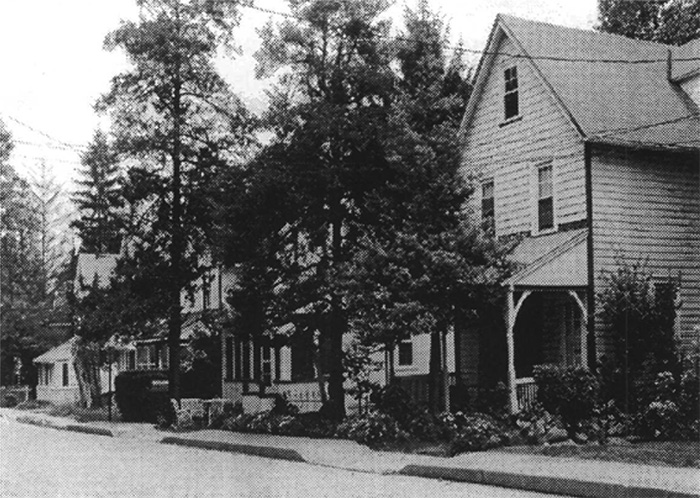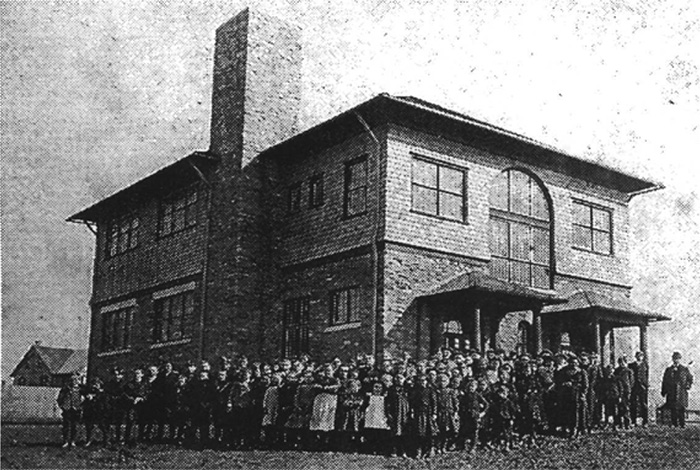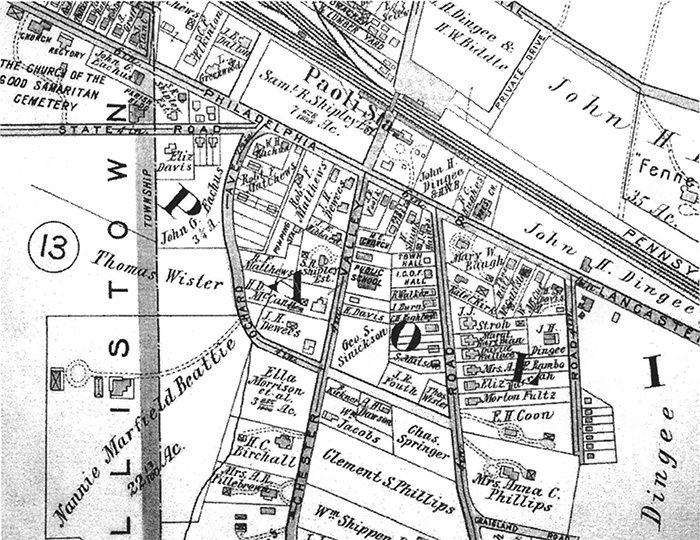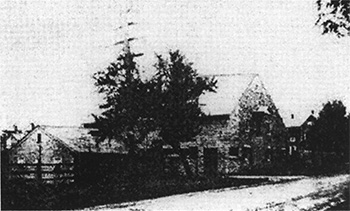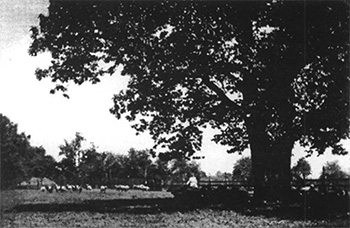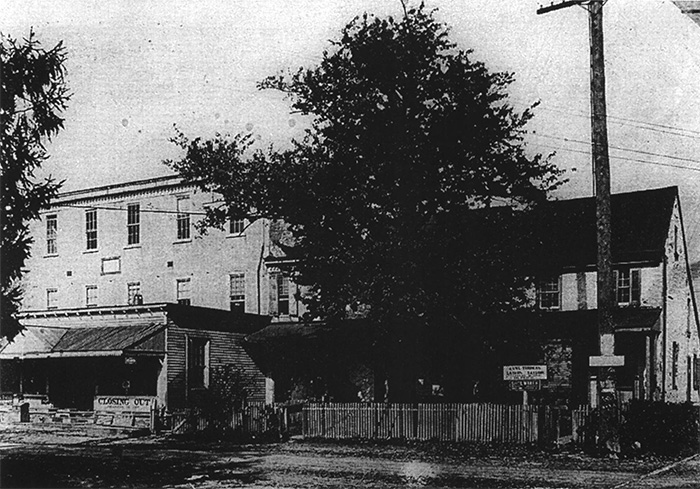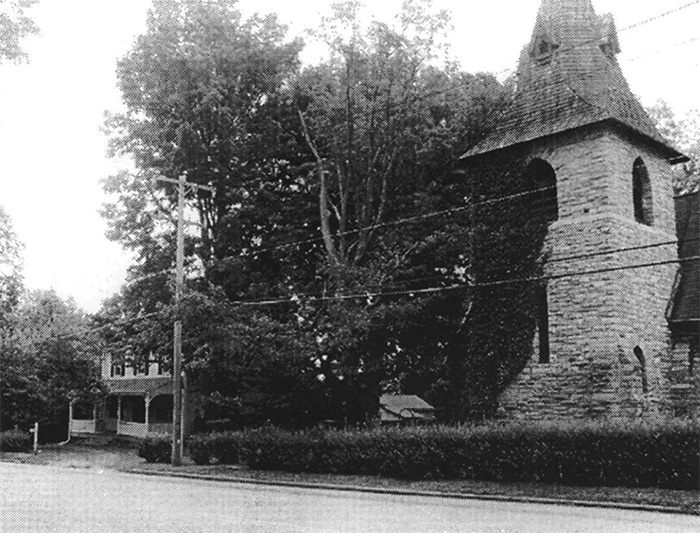|
Home : Quarterly Archives : Volume 40 |
Tredyffrin Easttown Historical Society |
|
Source: October 2003 Volume 40 Number 4, Pages 123–129 Growing Up in Paoli [This interview took place on January 24, 2000. Also participating was Mrs. Meagher's great-niece Ann Jones Seybert. Ann's father was Dr. Nelson Jones and her grandfather was Roy Jones, Mrs. Meagher's older brother.] One hundred years after her birth in Paoli, I had the privilege of visiting with Ethel Jones Meagher in Kimberton where she lives on her own with assistance from family members.* She vividly remembers many of the people, businesses, and activities of the community in the early 20th century. *Early in 2003 Mrs. Meagher moved to a retirement home where she continues to recall her childhood in Paoli. Ethel was born on January 8, 1900, on what is known today as Chestnut Road. Her family always called the street “Seven Stars” for the seven houses on the east side of the street. The Alfred Jones family lived in the sixth house. The house had a parlor, a large sitting room, large dining room, large kitchen, and an outside kitchen. The parlor was used only when the minister came to call and for funerals. When the Jones family acquired a piano, it was put in the parlor. Ethel played by ear. Her sister took lessons and played very well. Ethel said her sister often got out of domestic chores because their father liked to hear her play.
Five of the “Seven Stars” houses on the east side of Chestnut Road, looking north. September 12, 2003 photograph. Courtesy Roger D. Thorne. The area at the end of the street was known as Philip's Woods (now Paoli Woods townhouses). At the corner of Lancaster Pike and Chestnut there was a little school house which was later made into two apartments. A family by the name of Davis lived on the other corner; Mr. Davis had a livery stable. (Currently, the Christmas Shop occupies this corner.) Ethel was the 12th and last child born to her parents. Only six lived “to be any age.” During a diphtheria epidemic before Ethel was born, the family lost three young children in one day. The Yakes family lived on one side of the Jones family. Ethel recalls baby-sitting with George Yakes, pushing him around in his carriage. Both George and his brother, Everett, were dentists in Paoli in later years. The Seven Stars houses were occupied by railroaders. Six were conductors. Alfred Jones was a lever man at the Frazer tower, where there were two cutoffs. The main line continued west, and there was a line to West Chester and the cutoff to Trenton. Shortly before Mr. Jones died in 1911, the family moved to a double house on West Chester Pike (Paoli Pike) behind the current Matthews Ford building. The house had a bathroom and other “modern” conveniences that weren't available in the house on Seven Stars. The double house and a blacksmith shop, which are no longer in existence, were owned by a Mr. Leech. Ethel went to school on South Valley Road which is now an apartment house. The grammar school was on the first floor, with the high school grades on the second floor. This school had replaced the one on Chestnut Road about the time Ethel started to school. Ann Seybert's father also attended the South Valley Road school. By the time he got into the upper elementary grades, he attended the new Paoli School. Later he rode the train to Berwyn to attend Tredyffrin Easttown High School.
South Valley Road school. c 1913. Lucy Sampson, photographer. After 6th grade, Ethel left school. She had lost the use of her legs when her father died, and was incapacitated for six weeks. Her mother had four young children to raise, so Ethel didn't go back to school. At 11 years of age she went to work as a kitchen maid for the McCauley's. They lived on an estate near the present St. Norbert's Church. It was a big estate; Ethel remembers that they had seven maids
Many of the places mentioned in Ethel's interview appear on this section of
a 1912 map. The Seven Stars houses are in a row in the lower left corner and
back onto one of the large John H. Dingee properties where Ethel says she played.
The Davis property is shown on the southwest corner where the road the seven
houses are on meets Lancaster Pike. “Paoli Sta.” [station] is clearly labeled
in the upper center just south of the railroad tracks. The hill Ethel describes
sledding on is here on the short stretch of Valley Road between the railroad
tracks and station and Lancaster Pike. The school on South Valley Road is in
the middle and is labeled “Public School.” The Good Samaritan Church and
Rectory are in the upper left corner. What is thought to be Robert F. Matthews'
grocery store is represented by a small square on the southwest corner of where
a small unnamed street intersects with Lancaster Pike [just under the “HI”
of “Philadelphia” written on Lancaster Pike]. The Presbyterian Church [“PRES.
CH.”] and the Baugh property face each other across Lancaster Pike west of
another section of the Dingee property north of Lancaster Pike. The Bracken
Lumber Yard is at the upper center edge of the map north of the railroad tracks. The Dingee family owned land on both sides of the railroad tracks, including what is now the Paoli Shopping Center, the area that was later the Tredyffrin Country Club (southeast of the intersection of Routes 30 and 252), and land along East Central Avenue. The Dingee home, which is no longer in existence, was on the north side of the tracks. Opposite the Dingee property on Central Avenue was the Biddle estate. Ethel remembers playing in the fields behind their home on Chestnut, which was the dairy farm part of the Dingee property. They liked to “ride” the cows because there weren't horses on that land. “Course the cows threw us off, but we'd get on them anyway,” she said.
Dingee sheep barn on Chestnut Road. Date and photographer unknown.
Dingee farm sheep in a meadow thought to be where the Paoli Shopping Center
is now located. Date and photographer unknown. Ann Seybert recalls that you could sometimes see sheep where the Paoli Shopping Center is now. The Weichert Realtors building now standing at 101 East Lancaster Pike was originally the Dingee shepherd's cottage. In the last remodeling of the building, the cottage was completely covered. Schofield's Store at the northwest corner of Routes 30 and 252 sold dry goods and hardware, among other things. “He had everything,” Ethel said. She also recalled that the post office was located in Schofield's for a while.
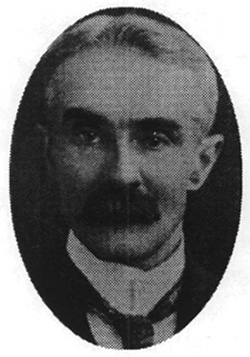
Above: Schofield's Store has a “closing out” sign in the lower left corner. It was also a post office and was one of the oldest buildings on Lancaster Pike in Paoli. Behind it is a still standing building on the northwest corner of Route 252 and Lancaster Pike that was a lodge hall at one time. Between 1940 and 1950 a bar and restaurant called the Green Lantern was at this location. The building at the right is no longer standing. Date and photographer unknown. Courtesy Tredyffrin Easttown History Club archives. Right: Henry Schofield was the postmaster from August 8, 1893 to 1897. 1893 portrait by Lucy Sampson. Courtesy Tredyffrin Easttown History Club archives. Ethel talked about the tollgate building, which is now a clock shop, just east of the Routes 30 and 252 intersection. “We used to go up there and sit with the tollgate man; sit there along the road and watch him taking fares.” Ethel's parents were founding members of the Good Samaritan Episcopal Church. Her father helped to dig the cellar for the chapel as his contribution to the building of the church. The baptismal font in the current church is the same one that was used when Ethel was baptized. Matthews grocery store on the corner of Lancaster Pike and Spring Street was another prominent location that Ethel remembers. They had a big butcher shop; the butchers were Mr. Clark and Mr. McKinley. Someone would come around once a week and take your grocery order; then your order would be delivered. Her brothers played baseball on the field which is now the residential Richmond Circle near Good Samaritan. Her oldest brother, Howard, was the manager, and her brothers played on the team. Ethel started going to classes to learn needlework when she was four years old. Mrs. Biddle and Mrs. Cox gave the classes at the Good Samaritan Church. Ann Seybert has a number of articles Ethel embroidered, including the first one she made.
Parsonage, left, and steeple, right, of the Good Samaritan Church Chapel with Route 30 (Lancaster Pike) in the foreground. September 12, 2003 photograph. Courtesy Roger D. Thorne. Ethel also went to dancing classes held in the parish house on Saturday nights. The cost was 15 or 20 cents a lesson. The teacher was Miss Nesbitt, daughter of the Episcopal minister in Narberth. At Christmas Mrs. Cox and Mrs. Biddle provided gifts for the Sunday School children. Up to six years of age a child could choose a toy. The older children had the choice of a prayer book, hymn book, or Bible. The Jones family had an unusual Christmas night treat. Ethel's mother would get a watermelon in the summer. She either shellacked or varnished it, wrapped it in newspaper, and put it in a dark corner until Christmas. Ethel says they were always delicious. Ethel remembers when the Presbyterian Church (now Baptist) on Lancaster Avenue was built. She stood on Dr. Baugh's corner (Lancaster Pike and Darby Road) to watch the laying of the cornerstone on October 14, 1906. 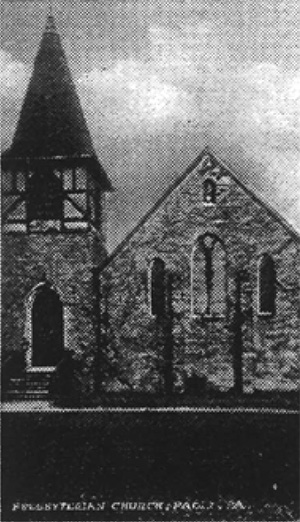
Presbyterian Church, Paoli. Tinted postcard. Ethel recalled that a man named Ed. Bracken had a lumber year near the Paoli station. Later Alleva's Coal was at this location. The first bank in Paoli was organized and built on Lancaster Avenue in 1923. Ethel told us that there was a little shack at this location before the bank was built. She and her siblings passed it on their way to school. It was an oyster house, which also sold penny candy. “We each got a penny every morning for recess and one for the afternoon,” she said, “and we'd stop there going to school to get our penny candy. But I didn't spend mine; I saved mine to buy bananas. I loved bananas. My brother Ed bought licorice sticks; I think he got four or five licorice sticks for a penny. I saved my pennies for a week; then the banana man would come along, and you could buy a dozen for 10 cents.” Ethel reminisced about sledding down North Valley Road from the train station. It was a long walk back up the hill, but “there were flat sleighs pulled by horses, so we'd catch one of them, hook on the back, and let the horses pull us up.” As we begin the 21st century, we are grateful to Ethel Jones Meagher for her recollections and descriptions of life in our area 100 years ago. |
